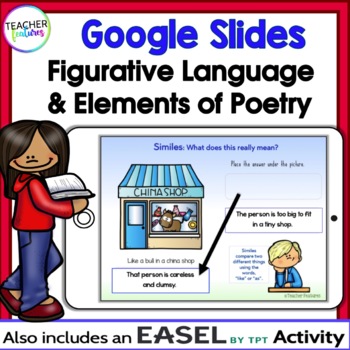ELEMENTS of POETRY & FIGURATIVE LANGUAGE Review Google Slides and EASEL Activity
- PDF
- Google Apps™
- Internet Activities
- Easel Activity
- Easel Assessment

What educators are saying
Description
This interactive Google Slides poetry elements activity is perfect for students to practice and review figurative language, idioms, hyperboles, similes, and metaphors, hyperbole, personification, alliteration and more! Perfect for independent work or literacy centers during Poetry Month. Simply "drag and drop" the interactive answers.
Vocabulary:
Simile, Metaphor, Hyperbole, Personification, Alliteration, Onomatopoeia, Verse, Rhythm, Rhyme, Rhyme Scheme, Meter and Stanza.
(89 digital GOOGLE SLIDES + EASEL Activity)
(ANSWER KEY ON SLIDES 1-24. STUDENT ASSIGNMENT ON SLIDES 26-115.)
★★★ This resource has an TpT Easel Activity AND EASEL Assessment already created for students.
Easel Activity (42 Pages): Students input their responses in answer boxes and to use other tools to draw and highlight. It is an Interactive layer over the original pdf. Click here to learn more about TpT’s digital activities. You can even edit the digital overlay or use it as is. After purchasing this resource, click the red Open in Easel button.
EASEL Assessment(30 Questions): You can assign through Google Classroom or via direct link. Students can complete and turn in on a laptop or tablet. Teachers can view auto- graded classroom performance by question and by student. No manual grading required.
CCSS.ELA-LITERACY.L.3.5
Demonstrate understanding of figurative language, word relationships and nuances in word meanings.
CCSS.ELA-LITERACY.L.3.5.A
Distinguish the literal and nonliteral meanings of words and phrases in context (e.g., take steps).
CCSS.ELA-LITERACY.L.4.5
Demonstrate understanding of figurative language, word relationships, and nuances in word meanings.
CCSS.ELA-LITERACY.L.4.5.A
Explain the meaning of simple similes and metaphors (e.g., as pretty as a picture) in context.
CCSS.ELA-LITERACY.L.5.5
Demonstrate understanding of figurative language, word relationships, and nuances in word meanings.
CCSS.ELA-LITERACY.L.5.5.A
Interpret figurative language, including similes and metaphors, in context.
©Teacher Features






